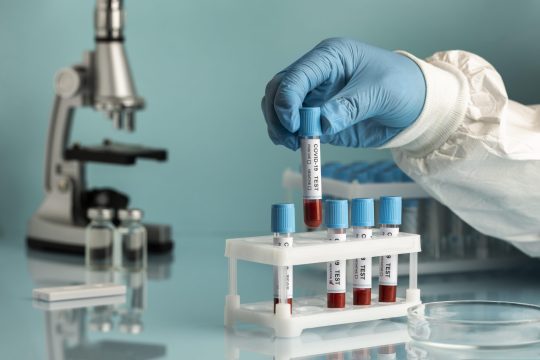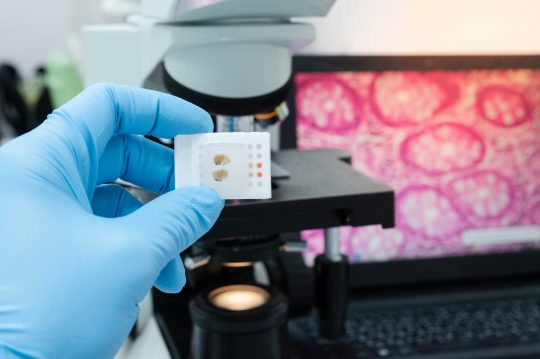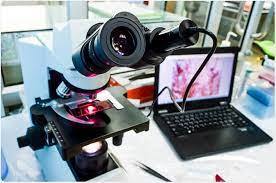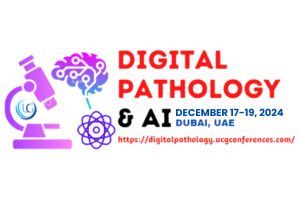#Telepathology
Text
0 notes
Text
telepathology
0 notes
Text
Digital Pathology
🔬 Embrace the future of medical diagnostics with Digital Pathology! 📊✨ This groundbreaking field combines the power of Artificial Intelligence (AI) and Telepathology to transform the way diseases are diagnosed. 🩺💻
🔍 Gone are the days of traditional microscopy—Digital Pathology brings a new level of precision and efficiency to the process. 📸💡 By digitizing tissue samples and leveraging AI algorithms, pathologists can analyze and interpret slides faster than ever before. ⏩💯
💪 Harnessing the immense potential of AI, Digital Pathology enhances accuracy and enables early detection of diseases. 🎯🧪 The advanced algorithms can detect subtle patterns and abnormalities that might be missed by human eyes alone. 🤖🔍
🌐 Furthermore, Telepathology takes collaboration and expert opinions to new heights. 👥💭 With the power of digital platforms, pathologists from different corners of the world can instantly access and discuss cases, leading to faster and more accurate diagnoses. 🌍📲
✨ Join the revolution in medical technology and witness the incredible advancements in Digital Pathology. Together, we are shaping a future where diagnoses are faster, more accurate, and accessible to all. 💙🌈
👩⚕️🤖 Stay tuned for more exciting updates as we explore the incredible potential of Digital Pathology! Share this post with your friends and spread awareness about this life-changing field. 💫💻
#DigitalPathology#AIinMedicine#Telepathology#MedicalRevolution#FutureofDiagnosis#InnovationInHealthcare#HealthTechAdvancements#AIAdvancements#DigitalTransformation#MedicalBreakthroughs
0 notes
Link
0 notes
Link
Whole Slide Imaging Market is poised to grow at a CAGR of 17.2 % by 2027. Factors driving the Whole Slide Imaging Market are increasing usage in drug discovery processes and technological advancements in whole slide imaging.
#whole slide imaging market#telepathology service market#whole slide imaging market size#whole slide imaging market share#whole slide imaging market forecast#whole slide imaging market trends#whole slide imaging industry
0 notes
Text
The globalonline doctor consultancy market is projected to reach USD 4.72 billion in 2023, registering a Compound Annual Growth Rate (CAGR) of 25.1% during the forecast period 2024-2030. The growth of the marketis majorly driven by rapid digitalization and internet coverage across globe.
0 notes
Text

India Diagnostic Laboratories Market size at USD 6.23 billion in 2023. During the forecast period between 2024 and 2030, BlueWeave expects the India Diagnostic Laboratories Market size to expand at a CAGR of 13.09% reaching a value of USD 9.31 billion by 2030. Diagnostic Laboratories Market in India is propelled by the growing elderly population and a rising prevalence of communicable diseases. These chains establish numerous laboratories and diagnostic centers across various cities and regions, including both urban and rural areas, thereby reaching a wider segment of the population. This expansion addresses healthcare disparities by providing services to underserved communities that previously had limited access to diagnostic facilities. As a result, the growth of these networks plays a pivotal role in bridging the healthcare gap and ensuring that more people receive timely medical testing. Overall, this strategic approach not only contributes to improved healthcare access but also fuels the broader growth of India diagnostics industry.
Opportunities – Expansion into rural areas
India Diagnostic Laboratories Market is expanding its reach into rural areas to address under-penetration compared to other countries. The low rate of pathology, CT, and MRI tests per 1,000 population highlights the need for broader diagnostic access in these regions. Despite market fragmentation and urban areas accounting for 74% of the diagnostic sector, new business models such as teleradiology and telepathology are emerging to improve access and quality. These innovations are designed to overcome the challenges posed by regulatory issues, commoditization, and limited specialized resources. By expanding into rural regions, the industry aims to offer more equitable healthcare services to India's diverse population.
Sample Request @ https://www.blueweaveconsulting.com/report/india-diagnostic-laboratories-market/report-sample
0 notes
Text
In 2022, the telehealth market reached a valuation of USD 87.2 billion
In 2022, the telehealth market was valued at USD 87.2 Billion. Projections indicate that by 2032, this market is anticipated to expand significantly, reaching a size of USD 737.5 Billion, driven by a robust Compound Annual Growth Rate (CAGR) of 23.9%.Telehealth encompasses the delivery of healthcare services remotely through telecommunications technology, including video conferencing, mobile apps, and digital platforms. This market has experienced remarkable growth due to technological advancements, rising healthcare costs, increasing demand for convenient healthcare solutions, and the imperative for improved access to medical services, particularly in underserved or rural areas.

Telehealth offers numerous benefits to both patients and healthcare providers, including greater convenience, reduced travel time and costs, improved access to specialists, and enhanced continuity of care. Patients can consult with healthcare professionals from the comfort of their homes, which is especially beneficial for individuals with mobility issues, chronic conditions, or those living in remote areas with limited access to healthcare facilities. Healthcare providers, on the other hand, can reach a broader patient population, optimize their schedules, and provide more timely and efficient care.Request Sample Report: https://datahorizzonresearch.com/request-sample-pdf/telehealth-market-2374The COVID-19 pandemic has further accelerated the adoption of telehealth, as social distancing measures and lockdowns prompted a shift towards virtual care delivery to minimize the risk of virus transmission. This unprecedented surge in telehealth usage has highlighted its potential to revolutionize healthcare delivery and reshape the healthcare landscape in the long term.The telehealth market encompasses a wide range of services, including virtual consultations, remote monitoring, telemedicine platforms, mobile health apps, and wearable devices. As technology continues to evolve and regulatory barriers are addressed, the telehealth market is expected to expand further, offering innovative solutions to address healthcare challenges and improve patient outcomes on a global scale.Looking Exclusively For Region/Country Specific Report? https://datahorizzonresearch.com/ask-for-customization/telehealth-market-2374Top Companies are:· Teladoc Health· Amwell· Good Rx· Talkspace· Doximity· Hims and Hers· InTouch Health· Plushcare· Medtronic· VSeeMarket Segmentations:Telehealth Market, By Modalities (2023–2032)· Live Video· Store- and- Forward· Remote Patient Monitoring· Mobile HealthTelehealth Market, By Monitoring Devices (2023–2032)· Blood Pressure Devices· Digital Thermometers· Blood Glucose Meters· Pulse Oximeters· OthersTelehealth Market, By Uses (2023–2032)· Teleconsultation· Telepathology· Remote Psychotherapy· Remote Home Medical Care· OthersTelehealth Market, By End-user (2023–2032)· Medical Practitioner· PatientBuy This Research Report: https://datahorizzonresearch.com/ask-for-customization/telehealth-market-2374Regional Analysis:In 2022, North America emerged as the dominant region in the telehealth market, with a significant market share. According to data from the U.S. Department of Health and Human Services, telehealth services were predominantly utilized by individuals aged 65 and above in the United States, followed closely by those aged 50 and above.The increasing adoption of telehealth among older demographics in the United States can be attributed to its cost-effectiveness and convenience, particularly for individuals who may face challenges in traveling to hospitals regularly for checkups. This trend towards telehealth services gained momentum during the COVID-19 pandemic, as restrictions on in-person healthcare visits prompted a widespread shift towards online medical consultations. Remarkably, many individuals have expressed their intent to continue utilizing telehealth services even after the pandemic subsides, underscoring the enduring appeal and benefits of virtual healthcare delivery.
0 notes
Text
Advancing Cancer Diagnosis: Integrating Immunohistochemical Staining with Digital Pathology
In the realm of cancer diagnosis and research, the integration of immunohistochemical (IHC) staining with digital pathology represents a significant leap forward. This powerful combination offers a multitude of benefits that enhance accuracy, efficiency, and collaboration in cancer pathology.
Immunohistochemical staining allows for the visualization of specific proteins within tissue samples, providing valuable insights into cancer biology. By targeting proteins associated with tumor markers, proliferation, and metastasis, IHC staining aids pathologists in characterizing tumors and guiding treatment decisions.

Digital pathology further elevates the capabilities of traditional microscopy by digitizing tissue slides and enabling remote access and analysis. With digital slides, pathologists can view high-resolution images on computer screens, facilitating collaboration among multidisciplinary teams and eliminating the need for physical slide transportation.

The integration of IHC staining with digital pathology offers several advantages:
Enhanced Visualization: Digital slides provide superior image quality and enable pathologists to zoom in and navigate through tissue sections with precision, enhancing visualization of staining patterns and cellular morphology.
Time Efficiency: Digital pathology streamlines workflow processes, reducing the time required for slide preparation, staining, and analysis. This efficiency translates to faster turnaround times for cancer diagnosis and treatment planning.
Data Accessibility: Digital slides can be easily archived and accessed for future reference, facilitating retrospective studies, quality assurance initiatives, and educational purposes.
Telepathology: Remote access to digital slides enables pathologists to consult with colleagues in real-time, regardless of geographical location. This capability enhances collaboration and facilitates expert consultations, particularly in underserved areas.
Machine Learning Integration: Digital pathology platforms can leverage machine learning algorithms to assist pathologists in analyzing large datasets and identifying subtle histological features, further enhancing diagnostic accuracy and efficiency.
The integration of immunohistochemical staining with digital pathology represents a transformative approach to cancer diagnosis and research. By harnessing the combined power of these technologies, healthcare providers can deliver more accurate and timely diagnoses, ultimately improving patient outcomes in the fight against cancer.
0 notes
Text

#Call for Speaker/Poster!!#We're always looking for inspiring Experts to share their research and experience at the 12th world digital pathology from December 17-19#2024 in Dubai#UAE & Virtual.#Register here: https://digitalpathology.ucgconferences.com/registration/#If you have any questions#WhatsApp us at https://wa.me/442033222718?text=#DigitalPathology#Pathology#PathologyAI#Telepathology#Pathologists#DigitalHistopathology#DigitalMicroscopy#PathologyInformatics#ImageAnalysis#PathologyResearch#PathologyConference#DigitalHealth#ArtificialIntelligence#MachineLearning#MedicalImaging
0 notes
Text
From Microscope Slides to Pixels: The Evolving Whole Slide Imaging Market
Introduction:
The Whole Slide Imaging (WSI) market is experiencing a remarkable transformation, redefining the field of pathology and diagnostics. Also known as virtual slide microscopy or digital pathology, WSI involves the scanning of entire microscope slides at high resolution and storing them as digital images. These digital slides can then be viewed and analyzed using specialized software, enabling pathologists, researchers, and healthcare professionals to make accurate diagnoses, collaborate remotely, and facilitate research. This technology is poised to revolutionize the way we approach healthcare and pathology.
Market Growth:
The Whole Slide Imaging market has been witnessing substantial growth in recent years, driven by a range of factors. The increasing prevalence of chronic diseases, such as cancer, is one of the primary drivers. WSI technology allows for rapid and accurate diagnosis, leading to better patient outcomes and treatment decisions. Moreover, the global expansion of telemedicine and telepathology has further fueled the demand for digital pathology solutions, allowing experts to collaborate across borders and share expertise more easily.
Advantages of Whole Slide Imaging:
1. Enhanced Diagnostic Accuracy: WSI provides pathologists with a detailed, high-resolution view of tissue samples, minimizing the potential for human error associated with traditional microscopy. This technology helps pathologists make more precise diagnoses, leading to improved patient care.
2. Remote Collaboration: WSI enables pathologists and experts to collaborate on cases regardless of their physical location. This is particularly valuable in areas with limited access to specialized medical professionals.
3. Efficient Workflow: Digital pathology streamlines the diagnostic process. Slides can be easily shared among multiple pathologists, and the ability to store and archive cases digitally reduces the physical storage requirements of glass slides.
4. Research Advancements: WSI supports cutting-edge research by facilitating the analysis of large datasets and enabling the integration of artificial intelligence (AI) and machine learning algorithms for automated diagnosis and pattern recognition.
Market Segmentation:
The WSI market can be segmented based on technology, application, end-users, and geography.
1. Technology: There are two primary types of WSI technology: brightfield and fluorescence. Brightfield technology is ideal for routine pathology, while fluorescence technology is used in research and specialized applications.
2. Application: WSI is employed in various applications, including telepathology, drug discovery, education, and research. Telepathology is particularly important for enabling remote consultation and diagnosis.
3. End-users: The end-users of WSI technology include hospitals, diagnostic laboratories, pharmaceutical companies, academic institutions, and contract research organizations. The adoption of WSI varies across these sectors.
4. Geography: The WSI market is distributed across regions such as North America, Europe, Asia-Pacific, and the rest of the world. North America, with its advanced healthcare infrastructure and supportive regulations, has been a prominent market.
Challenges and Future Trends:
Despite the substantial growth, the Whole Slide Imaging market faces a few challenges. These include the high initial cost of implementing WSI systems, concerns about data security, and the need for standardization in digital pathology. Furthermore, the technology still requires regulatory and reimbursement clarity in many regions to encourage broader adoption.
Looking to the future, the Whole Slide Imaging market is expected to continue growing as it overcomes these challenges. As AI and machine learning algorithms become more integrated, they will play an increasingly significant role in automating tasks like slide analysis. Furthermore, the emergence of cloud-based digital pathology solutions will provide cost-effective options for smaller healthcare facilities and academic institutions. The global adoption of WSI in pathology and diagnostics is set to become an integral part of the healthcare landscape, promising improved patient care, faster diagnoses, and more efficient collaboration among medical professionals.
Conclusion:
The Whole Slide Imaging market is experiencing substantial growth and is poised to revolutionize pathology and diagnostics. This transformative technology offers numerous advantages, including enhanced diagnostic accuracy, remote collaboration, streamlined workflows, and support for cutting-edge research. As the WSI market continues to evolve, overcoming challenges and embracing future trends, it will have a profound impact on healthcare and contribute to improved patient outcomes worldwide.
Few Other Promising Reports in Healthcare IT Industry
Behavioral Rehabilitation Market
Rehabilitation Equipment Market
Military Exoskeleton Market
Assistive Technology Market
0 notes
Text
Histology And Cytology Market :Size Share ,And Analysis During The Forecast Period From 2021-2028

The global Histology and Cytology Market is estimated to be valued at US$ 16,253.0 million in 2021 and is expected to exhibit a CAGR of 13.35% over the forecast period (2021-2028), as highlighted in a new report published by Coherent Market Insights.
Histology and cytology are important diagnostic tools used in medical and scientific research to study the cellular structure and function of tissues and cells. These techniques play a crucial role in the diagnosis of various diseases, such as cancer, infectious diseases, and autoimmune disorders. The market offers a wide range of products, including reagents, instruments, and consumables, to assist in histology and cytology procedures.
Market Dynamics:
The growth of the Histology and Cytology Market can be attributed to two key drivers. Firstly, the increasing prevalence of cancer and other chronic diseases is driving the demand for histology and cytology procedures. These techniques are essential for accurate diagnosis, staging, and prognosis of cancer, enabling timely and appropriate treatment decisions. Moreover, the rising geriatric population, which is more susceptible to chronic diseases, further contributes to the market growth.
Secondly, technological advancements in histology and cytology techniques are leading to improved accuracy, efficiency, and ease of use. For instance, automated staining systems help streamline laboratory workflows and reduce manual errors. Digital pathology solutions allow for remote access and efficient consultation among healthcare professionals. The integration of artificial intelligence and machine learning algorithms further enhances the diagnostic capabilities of these techniques.
SWOT Analysis:
Strengths:
1. Technological advancements in histology and cytology techniques
2. Increasing prevalence of cancer and chronic diseases
Weaknesses:
1. High cost of advanced histology and cytology equipment
2. Lack of skilled professionals for complex procedures
Opportunities:
1. Adoption of digital pathology solutions for telepathology and remote consultation
2. Growing focus on personalized medicine and targeted therapies
Threats:
1. Stringent regulatory requirements for histology and cytology procedures
2. Competition from alternative diagnostic techniques, such as molecular diagnostics
Key Takeaways:
The global Histology and Cytology Market Growth is expected to witness high, exhibiting a CAGR of 13.35% over the forecast period. The increasing prevalence of cancer and chronic diseases, coupled with technological advancements in histology and cytology techniques, are driving the market growth. In terms of regional analysis, North America is expected to dominate the market, followed by Europe and Asia Pacific. The presence of a well-established healthcare infrastructure, high healthcare expenditure, and favorable reimbursement policies contribute to the growth of the North American market.
Key players operating in the global Histology and Cytology Market include Abbott, Hologic Inc., Becton, Dickinson and Company, Southwest Precision Instruments, LLC, F. Hoffmann-La Roche Ltd, Sysmex Corporation, Thermo Fisher Scientific Inc., Danaher, Life Technologies Corporation, Merck KGaA, Koninklijke Philips N.V., Perkin Elmer, and Trivitron Healthcare. These companies are focusing on product innovation, strategic collaborations, and mergers and acquisitions to strengthen their market position and expand their product portfolios.
#Histology And Cytology Market#Coherent Market Insights#Histology And Cytology Market Value#Histology And Cytology Market Size#Histology And Cytology Market Share#Histology And Cytology Market Growth#Histology And Cytology Market Analysis
0 notes
Text
Digital Pathology Market Is Estimated To Witness High Growth Owing To Increasing Adoption of Telepathology

The global Digital Pathology Market is estimated to be valued at US$ 884.4 million in 2023 and is expected to exhibit a CAGR of 12.2% over the forecast period, as highlighted in a new report published by Coherent Market Insights.
A) Market Overview:
Digital pathology is an advanced technology that involves the management, storage, and interpretation of pathology information in a digital format. It eliminates the need for physical slides and allows easy access to patient data for analysis and diagnosis. This technology offers numerous advantages such as enhanced accuracy, faster turnaround time, remote consultation, and improved collaboration among pathologists. The need for digital pathology solutions is driven by the rising demand for efficient diagnostic tools and the increasing complexity of pathological slides.
B) Market Key Trends:
One key trend in the global Digital Pathology market is the increasing adoption of telepathology. Telepathology allows pathologists to remotely access and interpret pathology images, enabling them to provide expert opinions and consultations regardless of geographical barriers. This trend has gained significant momentum due to the COVID-19 pandemic, which has increased the need for remote work and virtual healthcare solutions. Telepathology not only improves access to pathology expertise in underserved areas but also facilitates multi-disciplinary collaboration and enables faster diagnosis and treatment decisions.
C) PEST Analysis:
- Political: Regulatory policies and guidelines play a crucial role in the adoption of digital pathology solutions. Governments worldwide are focusing on enhancing healthcare infrastructure and promoting digitization in healthcare.
- Economic: The growing healthcare expenditure and increasing burden of chronic diseases are driving the demand for digital pathology solutions. Moreover, advancements in technology and cost reduction of digital pathology systems are also contributing to market growth.
- Social: The growing geriatric population, increasing prevalence of chronic diseases, and rising awareness about personalized medicine are factors driving the need for accurate and efficient diagnostic tools like digital pathology.
- Technological: Advancements in image analysis software, machine learning, and artificial intelligence have revolutionized digital pathology. These technologies enable automated analysis, better accuracy, and faster diagnosis, thereby boosting market growth.
D) Key Takeaways:
- The global Digital Pathology Market Demand is expected to witness high growth, exhibiting a CAGR of 12.2% over the forecast period, due to the increasing adoption of telepathology.
- North America is the fastest-growing and dominating region in the digital pathology market, attributed to the presence of well-established healthcare infrastructure, a high burden of chronic diseases, and a supportive regulatory environment.
- Key players operating in the global Digital Pathology Market include Leica Biosystems Nussloch GmbH, Olympus Corporation, F. Hoffmann-La Roche Ltd., Merck KGaA, GE Healthcare, Mikroscan Technologies, Inc., Koninklijke Philips N.V., Sectra AB, Propath UK Limited, Inspirata, Inc., Hamamatsu Photonics, Inc., OracleBio Limited, MD Biosciences, Aiforia, Xybion Digital Inc., and Nucleai, Inc.
In conclusion, the global Digital Pathology Market is experiencing significant growth due to the increasing adoption of telepathology and advancements in technology. This market has immense potential to improve diagnostic accuracy, enhance collaboration among pathologists, and facilitate remote consultations. As healthcare systems continue to embrace digitization, the demand for digital pathology solutions is expected to soar in the coming years.
#Digital Pathology#Digital Pathology Market#Digital Pathology Market Share#Digital Pathology Market Segments#Digital Pathology Market Size#Medical Devices
0 notes
Text
Digital Pathology Market Is Estimated To Witness High Growth Owing To Increased Adoption Of Digital Pathology Solutions And Rising Demand For Efficient Diagnostic Methods

A) Market Overview:
Digital pathology is a revolutionary technology that involves the capturing, managing, and interpreting of digital images from pathology slides. It eliminates the need for physical slides by digitizing them, allowing pathologists to view and analyze them using computer platforms. Digital pathology enables efficient storage, retrieval, and sharing of pathology images, making it a valuable tool in research, education, and diagnosis. The market offers various products such as scanners, software, and storage systems that enable the conversion of analog pathology slides to digital format
The global Digital Pathology Market is estimated to be valued at USD 884.4 million in 2023 and is expected to exhibit a CAGR of 12.2% over the forecast period 2023-2030, as highlighted in a new report published by Coherent Market Insights.
B) Market Dynamics:
Increasing Adoption of Digital Pathology Solutions: The adoption of digital pathology solutions is steadily increasing, driven by the advantages they offer over traditional pathology methods. These solutions enable remote access, collaboration, and quick turnaround time for diagnosis, leading to improved patient outcomes. Additionally, digital pathology eliminates the risk of slide loss or damage and allows easy sharing of images for second opinions or consultation.
Rising Demand for Efficient Diagnostic Methods: The growing burden of diseases and the need for accurate and timely diagnoses are fueling the demand for efficient diagnostic methods like digital pathology. Digital pathology provides high-resolution images that allow pathologists to zoom in, annotate, and analyze tissue sections in detail. This enhances diagnostic accuracy and efficiency, leading to better patient management and treatment decisions.
C) Market Key Trends:
An emerging trend in the Digital Pathology Market Trends is the integration of artificial intelligence (AI) for image analysis and interpretation. AI algorithms can analyze large sets of pathology images, detect patterns, and provide automated diagnoses or assist pathologists in their diagnoses. This trend is revolutionizing the field of pathology, enabling more precise and faster diagnoses, especially in complex cases. For example, AI algorithms can identify cancerous cells, predict disease progression, and provide personalized treatment recommendations.
D) SWOT Analysis:
Strengths:
Efficient and accurate diagnosis
Improved collaboration and remote access
Weaknesses:
High upfront costs of digital pathology solutions
Limited adoption in developing regions due to infrastructure limitation
Opportunities:
Integration of AI for advanced image analysis
Expansion of digital pathology in telepathology and research applications
Threats:
Data security and privacy concerns
Resistance from traditional pathologists to switch to digital methods
E) Key Takeaways:
- The global digital pathology market is expected to witness high growth, exhibiting a CAGR of 12.2% over the forecast period, due to the increasing adoption of digital pathology solutions and the rising demand for efficient diagnostic methods.
- North America is anticipated to be the fastest-growing and dominating region in the digital pathology market, driven by advanced healthcare infrastructure, favorable reimbursement policies, and the presence of key market players.
- Key players operating in the global digital pathology market include Leica Biosystems Nussloch GmbH, Olympus Corporation, F. Hoffmann-La Roche Ltd., Merck KGaA, GE Healthcare, Mikroscan Technologies, Inc., Koninklijke Philips N.V., Sectra AB, Propath UK Limited, Inspirata, Inc., Hamamatsu Photonics, Inc., OracleBio Limited, MD Biosciences, Aiforia, Xybion Digital Inc., and Nucleai, Inc.
In conclusion, the digital pathology market is experiencing significant growth due to the increasing adoption of digital pathology solutions and the rising demand for more efficient diagnostic methods. The integration of AI in digital pathology and the expansion of its applications present exciting opportunities for market growth. However, challenges such as high upfront costs and data security concerns need to be addressed for widespread adoption. Overall, digital pathology has the potential to transform pathology practices and improve patient outcomes.
#Digital Pathology Market#Digital Pathology Market Demand#Digital Pathology Market Sale#Digital Pathology Market trends#Digital Pathology Market Growth#Digital Pathology Market Analysis#Coherent Market Insights
0 notes
Text
Next-Gen Digital Pathology Conference 2023: Bridging Pharma and Cutting-Edge Pathology Innovations

In the rapidly evolving landscape of healthcare, the integration of technology has paved the way for remarkable advancements. One such groundbreaking transformation is the intersection of pharmaceuticals and digital pathology. The amalgamation of these two fields has not only streamlined diagnostics but also revolutionized drug development and patient care. This blog delves into the multifaceted role of pharmaceutical companies in digital pathology, highlighting upcoming innovations, compelling case studies, and cutting-edge research.
THE INTERSECTION OF PHARMA AND DIGITAL PATHOLOGY: A SYNERGISTIC PARTNERSHIP
Digital pathology involves the digitization of pathology slides, allowing for easier storage, analysis, and sharing of images. In this era of big data and artificial intelligence (AI), pharmaceutical companies have found themselves at the forefront of leveraging digital pathology for a multitude of purposes.
1. Drug Discovery and Development: Pharmaceutical companies are utilizing digital pathology to accelerate the drug discovery process. With the help of AI algorithms, they can analyze tissue samples more efficiently, identifying potential drug targets and biomarkers. This approach expedites preclinical and clinical studies, ultimately shortening the time it takes for new drugs to reach patients.
2. Personalized Medicine: The advent of digital pathology has paved the way for personalized medicine. By analyzing individual patient data, pharmaceutical companies can tailor treatments based on a patient's unique genetic and molecular profile. This precision approach not only enhances treatment efficacy but also minimizes adverse effects.
3. Clinical Trials: Digital pathology aids in streamlining clinical trials by facilitating remote collaboration among researchers and experts. Pathological assessments can be conducted more effectively, ensuring accurate data interpretation, and reducing trial timelines.UPCOMING INNOVATIONS IN PHARMA AND DIGITAL PATHOLOGY
The marriage of pharmaceuticals and digital pathology continues to evolve, with several exciting innovations on the horizon:
1. AI-Powered Diagnostics: Advanced AI algorithms are being developed to assist pathologists in diagnosing diseases more accurately and rapidly. These algorithms can analyze vast amounts of data, aiding pathologists in making informed decisions.
2. Virtual Tumour Boards: Pharma companies are exploring virtual tumour boards where pathologists, oncologists, and other experts can collaborate in real-time, leading to more comprehensive treatment strategies.
3. Telepathology Solutions: Remote consultation and diagnosis through telepathology are becoming increasingly feasible, allowing experts to offer their insights regardless of geographical constraints.CASE STUDIES AND RESEARCH BREAKTHROUGHS
Several case studies highlight the successful integration of pharma and digital pathology:
1. Merck's Cancer Biomarker Discovery: Merck utilized digital pathology to identify potential cancer biomarkers, accelerating their drug development pipeline.
2. Novartis' Precision Medicine: Novartis leveraged digital pathology to identify patient subgroups likely to respond to a certain drug, ensuring a more personalized approach to treatment.
3. Pfizer's Drug Safety Assessment: Pfizer employed digital pathology to enhance the assessment of drug safety, improving decision-making in the drug development process.MARKET INSIGHTS AND THE NEXT-GEN DIGITAL PATHOLOGY CONFERENCE
The connection between the blog topic and the forthcoming MarketsandMarkets Next-Gen Digital Pathology Conference, scheduled for October 19th-20th, 2023, in Boston, USA, is evident. This conference serves as a platform for industry leaders, researchers, and experts to converge and share insights about the latest developments in digital pathology and its interface with pharmaceuticals.
The early bird discount of 20% with code DGPB20, expiring on August 31st, 2023, presents a valuable opportunity for participants to engage with pioneering minds, explore innovations, and gain a comprehensive understanding of the dynamic landscape of pharma and digital pathology.
Conclusion
The symbiotic relationship between pharmaceuticals and digital pathology has ushered in a new era of healthcare. As pharmaceutical companies continue to leverage digital pathology for drug discovery, personalized medicine, and clinical trials, the impact on patient care and treatment outcomes is immeasurable. The upcoming MarketsandMarkets Next-Gen Digital Pathology Conference is a prime platform to stay updated on these transformative developments, offering a chance to be part of the cutting-edge dialogue that shapes the future of healthcare.
Seize the opportunity and register now to avail the early bird discount before it expires on August 31st, 2023.
0 notes
